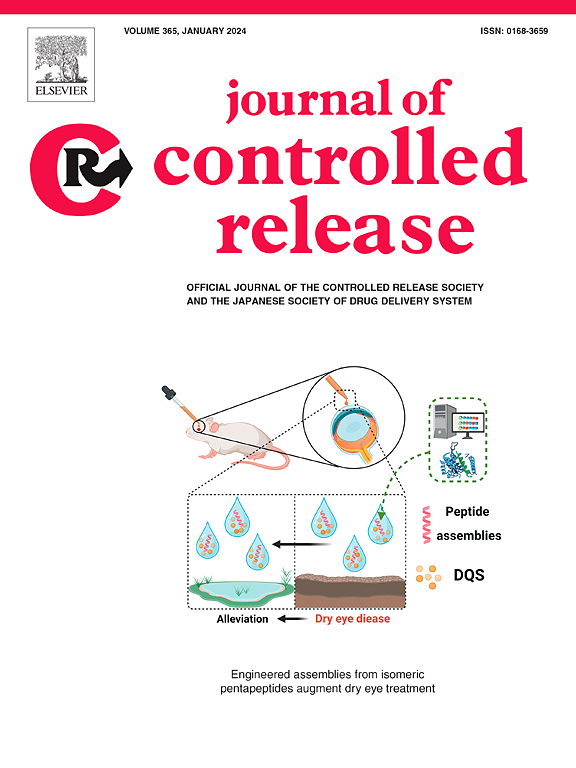Metal phenolic networks-driven bufalin homodimeric prodrug nano-coassemblies for ferroptosis-augmented tumor therapy
IF 10.5
1区 医学
Q1 CHEMISTRY, MULTIDISCIPLINARY
引用次数: 0
Abstract
Poor bioavailability and dose-limiting cardiotoxicity persistently hinder the clinical application of bufalin (BF). Conventional BF-based nanoagents have shown promise in tackling these challenges, yet advanced nanostrategies with further improved performance and clinical accessibility still await development. Herein, we introduce a novel cooperative nanoparadigm based on disulfide-linked BF homodimeric prodrugs (SBF) and metal-phenolic networks (MPNs). This strategy achieves high drug-loading capacity and structural stability. Stability perturbation experiments reveal that hydrophobic interactions, electrostatic adsorption, and coordination bonds synergistically drive co-assembly of SBF and MPNs. The resultant nanopartieles (MSBNAs) exhibit prolonged circulation kinetics, tumor-selective accumulation, and pH/GSH dual-responsive properties, effectively mitigating BF-induced cardiotoxicity. Further antitumor mechanistic investigations unveil that MSBNAs amplify BF-induced ferroptosis through a dual assault of oxidative stress and iron overload induced jointly by MPNs-delivered exogenous iron and BF-triggered endogenous iron. This increased ferroptosis endows MSBNAs with superior suppression of tumor growth and lung metastasis, maintaining excellent biocompatibility without cardiotoxicity. Our work not only establishes a promising candidate platform to surmount the therapeutic hurdles of BF but also enriches the design landscapes of co-assembled nanomedicines, thereby laying a foundation for the clinical translation of BF and other antitumor drugs.


金属酚网络驱动的蟾毒灵同二聚体前药纳米共聚体用于嗜铁增强肿瘤治疗
生物利用度差和剂量限制性心脏毒性一直阻碍着蟾毒灵的临床应用。传统的基于bf的纳米药物已经显示出解决这些挑战的希望,然而具有进一步改善性能和临床可及性的先进纳米策略仍有待开发。在此,我们介绍了一种基于二硫化物连接的蟾毒灵同源二聚体前药(SBF)和金属酚网络(mpn)的新型协同纳米范式。该策略具有较高的载药能力和结构稳定性。稳定性微扰实验表明疏水相互作用、静电吸附和配位键协同驱动SBF和mpn的共组装。由此产生的纳米颗粒(MSBNAs)表现出延长循环动力学,肿瘤选择性积累和pH/GSH双响应特性,有效减轻bf诱导的心脏毒性。进一步的抗肿瘤机制研究揭示,MSBNAs通过mpns传递的外源性铁和bf触发的内源性铁共同诱导的氧化应激和铁过载的双重攻击,放大了bf诱导的铁凋亡。这种铁下垂的增加使MSBNAs具有优越的抑制肿瘤生长和肺转移的能力,保持良好的生物相容性而没有心脏毒性。我们的工作不仅为克服BF的治疗障碍建立了一个有前景的候选平台,而且丰富了协同组装纳米药物的设计景观,从而为BF和其他抗肿瘤药物的临床转化奠定了基础。
本文章由计算机程序翻译,如有差异,请以英文原文为准。
求助全文
约1分钟内获得全文
求助全文
来源期刊

Journal of Controlled Release
医学-化学综合
CiteScore
18.50
自引率
5.60%
发文量
700
审稿时长
39 days
期刊介绍:
The Journal of Controlled Release (JCR) proudly serves as the Official Journal of the Controlled Release Society and the Japan Society of Drug Delivery System.
Dedicated to the broad field of delivery science and technology, JCR publishes high-quality research articles covering drug delivery systems and all facets of formulations. This includes the physicochemical and biological properties of drugs, design and characterization of dosage forms, release mechanisms, in vivo testing, and formulation research and development across pharmaceutical, diagnostic, agricultural, environmental, cosmetic, and food industries.
Priority is given to manuscripts that contribute to the fundamental understanding of principles or demonstrate the advantages of novel technologies in terms of safety and efficacy over current clinical standards. JCR strives to be a leading platform for advancements in delivery science and technology.
 求助内容:
求助内容: 应助结果提醒方式:
应助结果提醒方式:


